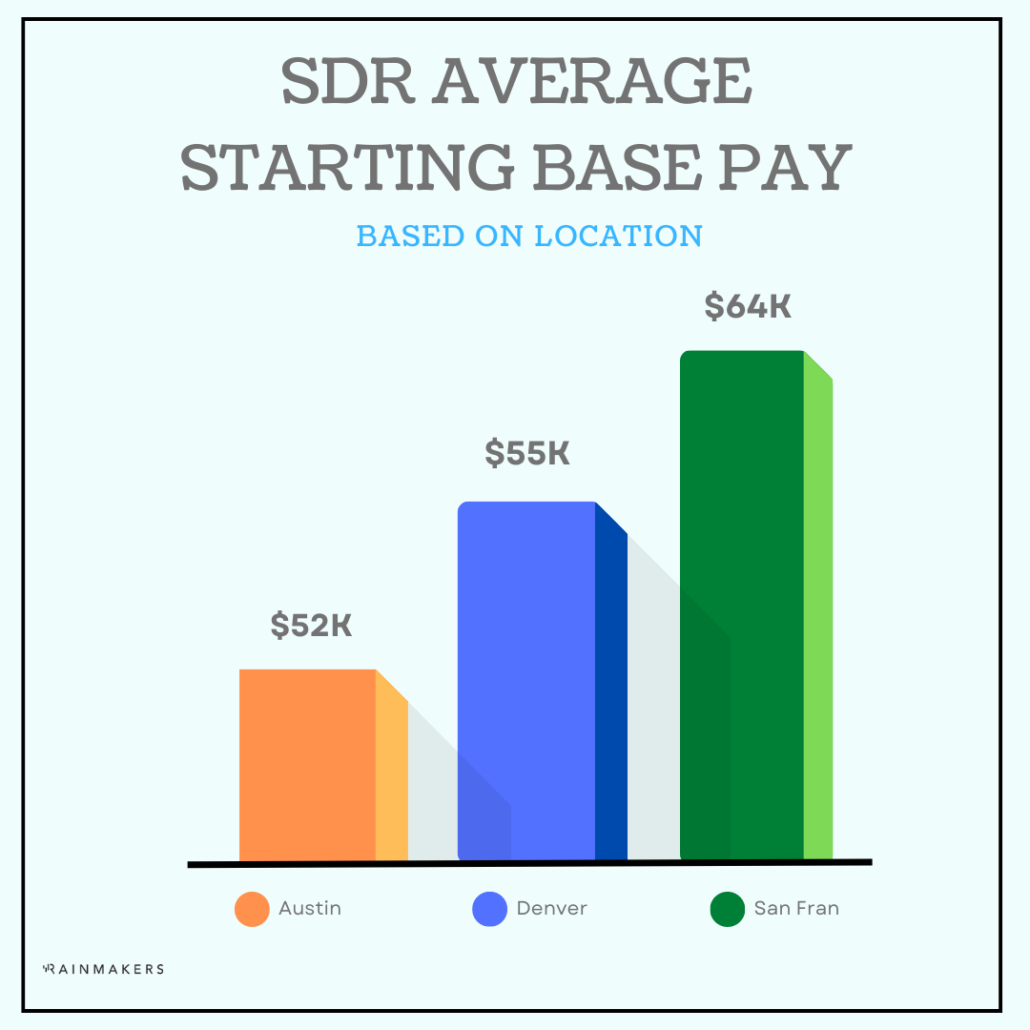SDR Salary Guide
How Much Do Sales Development Representatives Make?
It’s getting increasingly challenging to find top SaaS sales talent. In order to identify the best potential sales team members, internal and external recruiters are searching LinkedIn, online job boards, and other resources to find qualified Sales Development Representatives (SDRs) to help fill your team.
Following their experiences working from home during Covid, sales staff are looking for remote employment opportunities that provide flexibility and require less travel time. This is the case everywhere across the country, and it presents challenges in sourcing acceptable individuals and what to offer in terms of base salary and OTE.
As market leaders in hiring tech salespeople, Rainmakers provides a transparent, data-driven platform to efficiently match top salespeople with the most intriguing and forward-thinking tech firms. The SDRs with the highest potential are consequently linked with the most suitable opportunities that meet their qualifications.
How Much Does the Average Tech SDR Get Paid?
Positions as a Sales Development Representative (SDR) are frequently entry-level. Because most candidates have little to no sales experience, it can be challenging to calculate typical pay.
According to data from the Rainmakers platform, an SDR’s base income tends to start at a little under $59k and an OTE of almost $81k. However, SDR compensation will vary due to differences in regional living expenses.
High-demand areas such as San Francisco and New York will command a higher starting base pay—closer to $64k, with OTEs up to $86k. While still a powerhouse in tech development and sales, Denver would pay a bit less with $55k base pay and $83k in OTE.
Because SDR employment is entry-level, pay rarely rises significantly as one gains experience. According to Rainmakers’ research, between five and seven years of experience, on-target earnings start to decline. After seven years, growth resumes, although this is often a result of many sales representatives moving up to management and lead positions.

Being a Sales Development Representative
Sales development representatives begin by researching prospective customers to deliver promising sales-qualified leads (SQLs) to account executives for further contact.
The “outbound sales” procedure starts with the SDR locating a potential customer. They then contact them and pass the prospect to another sales team member. While Account Executives are responsible for closing deals, the SDR primarily focuses on research, outreach, lead qualifying, and facilitating the initial meeting with the account executive.
By using SDRs, businesses can divide their sales divisions into specialized teams with in-depth knowledge of particular sales process stages. This strategy works well because it streamlines the lead-to-closing process and enables everyone to work more effectively and successfully.
The best SDRs have a committed mentality, good sales skills, and an awareness of buyer personas. They should also have the persistence and inventiveness that makes things happen. A top-notch SDR should be able to recognize the problems and troubles that prospects are having, then explain how they can help.
They must also have strong research skills. A good Sales Development Representative must be able to “deep dive” into a potential client’s needs to uncover demographic information. Then they must communicate their findings to the Account Executive.
How Long Does an SDR Position Last?
That’s difficult to predict, and much depends on the size of the sales team and the target markets. The larger the company, the longer an individual may continue to fill an SDR role before moving up in the sales team. So while a small business may offer quicker promotion opportunities, overall earnings may be less than a similar position at a larger company. Slower promotion can be made up for with greater OTE earnings, but the SDR’s skill set must also be greater.
On average, SDR positions serving small businesses may last up to a year and a half. Those serving mid-market businesses can last up to two years. And those SDRs targeting enterprise businesses could see themselves staying in that position for two to four years.

After Being an SDR, What’s Next?
SDRs pick up many skills while performing their duties. And they’ve had plenty of opportunities to watch Account Executives and other sales team members.
After working further to develop skills such as communication, problem-solving, teamwork, and time management, SDRs can begin exploring the next step of their career. Often, the next logical stage of a sales career would be a closing, quota-carrying position such as Account Executive (AE).
Account Executives are responsible for managing customer accounts. Typical duties of AEs include prospecting for new business, running demos, attending to the needs of current clients, and, most importantly, closing transactions that will bring in new customers and generate income for the firm. For example, where the Sales Development Representative develops initial interest and sets up the first sales meeting, the AE is responsible for following up and closing the deal.
Beyond that, an SDR can move on to roles such as Mid-Market Account Manager, Enterprise Account Manager, or Customer Success Manager. However, these positions and others above will almost always require time spent as an Account Executive.
What Cities Are the Best For SDR Jobs?
The West Coast and innovative technology go hand in hand in many peoples’ minds. The region of Northern California, known as Silicon Valley, is widely regarded as the birthplace of the modern technology sector. San Francisco is one of the leading cities that has benefited from its proximity to the technology sector and its large pool of skilled workers.
Other cities across the US are also becoming innovation hubs for information technology, primarily due to widespread technological advancements. On the East Coast, New York City is in the lead, and it is on par with San Francisco in terms of the number of potential customers for SaaS sales representatives. Atlanta, Austin, Chicago, Denver, Los Angeles, Phoenix, and Raleigh are other cities that rank highly in terms of their SaaS sales markets.

SDR Opportunities At Rainmakers
Rainmakers only considers the most qualified candidates for employment, allowing you to confidently interview the highest-quality sales professionals. When we look at potential candidates, we review their sales statistics, such as their performance, what they have sold, and who they have sold to. This enables you to economize valuable time by quickly identifying candidates with the required skills, experience, and personality traits.
Get in touch with us today to learn more about how we can assist you in hiring the best team members for your tech sales initiatives.










